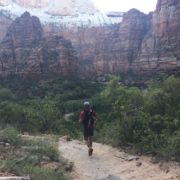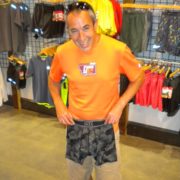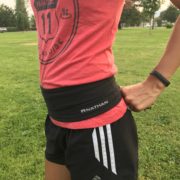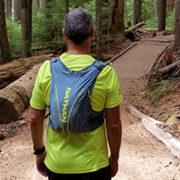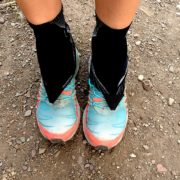Nate Bender is quickly becoming a local legend for mountain travel prowess. He trained all summer for an attempt at all 27 of Montana’s 12,000′ mountains only to be snowed out a few days before. Not one to complain, he quickly adjusted plans and drove down to Zion to attempt an FKT on the double-Zion traverse. All the while he tested out the UltrAspire 600 Lumen waistbelt. Follow more of his adventures @10peaksbeforelunch.
Put away the smoke masks and break out the puffy jackets, fall has come to Missoula. And if you go a little higher in the hills, you can find full-on winter. Some folks are already binge-watching TGR ski films and others just wish they could have a few more weeks of running in the high alpine, but whatever your views one thing is for certain — the changing weather means the days are getting shorter and having a good light for your pre-dawn and post-work runs is crucial.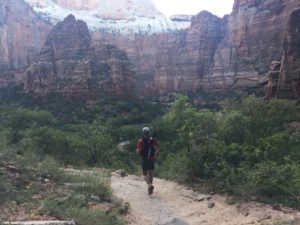
I’ve always been solely a headlamp kind of guy, but I jumped at the chance to test out a waist light. For longer-duration efforts, I liked the idea of doubling up on light sources by adding a waist light in addition to a headlamp. Ultraspire claims that having the light beam come from waist height makes shadows from rocks and roots more pronounced and gives better depth perception. And with my ability to trip over anything and everything, this seemed like a great reason to carry a few extra ounces. Plus, I knew everyone would be jealous of my impressively glowing crotch area.
First impression — the Ultraspire Lumen 600 Waist Light is a serious piece of gear. The light itself feels solid and well-built, without feeling heavy, and the adjustable mesh waist belt (made out of the same materials Ultraspire makes their packs from) felt comfortable and well-thought-out, with two pockets for accessories and a wide belt to give the light some support and keep it from bouncing around too much.
HOW’D IT DO ON THE TRAILS?
I took the light out for several training runs around town and on Mount Sentinel, both with and without an additional headlamp. The big test, though, was using it on the Zion Double Traverse — 96 miles end-to-end-to-end through Zion National Park.
The light boasts four modes: low, medium, high, and a quickly blinking SOS mode (also known as, “for the love of god, car, I’m just trying to get home from the trailhead please don’t hit me.”) The low setting is adequate for hiking, or a slow jog on relatively open trails. The medium works well for a wide range of speeds and terrain, and the high is great for fast running on uneven terrain; it really puts out an impressive amount of light. You turn the light on and cycle through the modes with a single button. If you’re trying to cycle to a different mode while running fast through rocks this could be an issue as you’d have to cycle the light off as you clicked through to the mode you wanted, but other than a scenario like that this system is pretty foolproof. 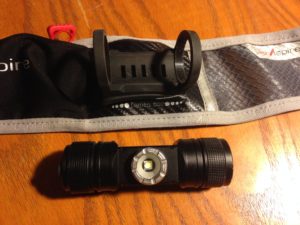
The light attaches to the waist belt with two flexible rubber rings which allow the light to swivel up and down. You can definitely angle the light too high, to the point that you start to see it in the bottom of your peripheral vision. But that puts the angle of the light so high I can’t think of any reason why it would ever need to be set like that.
And full disclosure — in the interest of saving weight, I took the light off the waist belt for the Zion run and improvised a way to attach the light directly to the front of my running pack. Probably not what the designers had in mind, but it worked like a charm so I’d say it’s a positive that the light is versatile like this.
But on the runs I did with the light attached to the waist belt as it’s supposed to be I found the belt fit securely. I did have to keep tucking the excess tail ends of the adjustable part so they wouldn’t bounce around. If you’re on the smaller side like me you might consider trimming these down a bit.
The light does bounce around, especially if you’re running quickly or descending a technical bit of trail, but it was never enough to feel distracting. It also became less noticeable if I paired the light with a headlamp, which I recommend for longer excursions. With just the waist belt, I found looking at something off to the side of the trail or in your pack took a bit of hip gymnastics, usually ending with me awkwardly crouching over my pack to get the light to shine at the right angle. Not the most glamorous, or efficient. An additional headlamp avoids all that, makes it much easier to see off to the side of the direction you’re going, and on some rockier trails the more lumens you can throw out the merrier.
The beam is also significantly wider than a standard headlamp’s, and I’d imagine this could be a good thing or bad thing depending on the person. Some people may like how the wider beam reduces the tunnel vision effect that a relatively narrow headlamp beam gives, while others may not really care to see what the bushes five feet on either side of the side of the trail look like.
The biggest downside I’ve found with the light so far came during the late stages of the Zion run, when the battery didn’t have enough charge to stay on the high setting and could only muster the medium brightness. At the beginning of the run I’d started in the dark and ran with the light on for a couple hours until daybreak. Then I completely forgot to tell my crew to charge it during the day. At about 1 in the morning I’d been on the move for over 20 hours, I was having trouble staying awake, and the light didn’t have enough power to stay on the high setting. It wasn’t a deal breaker — the medium beam still throws out a good amount of light — but I was fatigued enough that I was grasping at anything that would make the effort easier, and putting out more lumens seemed like a great way to keep myself more alert. So this tal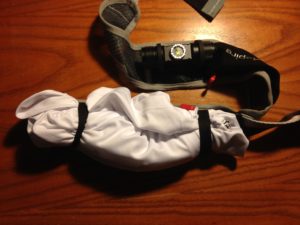 e isn’t really a gripe against the light so much as it is just something good to know; if you’re on a really long run or just happen to be more tired than usual, the medium beam may feel underwhelming in a way that it doesn’t on shorter outings.
e isn’t really a gripe against the light so much as it is just something good to know; if you’re on a really long run or just happen to be more tired than usual, the medium beam may feel underwhelming in a way that it doesn’t on shorter outings.
WHAT CAN I FIT IN THE BELT?
The waist belt comes with two pockets; a smaller one in the front and a larger one in the back. Both open with these easy-to-pull red rubber tabs. They’re easy to grasp even with light gloves. The front pocket can fit an iPhone 5 comfortably. The back pocket can fit twelve energy gels (true) or 57 peanut M&Ms (I might’ve made that up). There are also two grippy elasticized loops on either side of the back pocket that you can slide a jacket or extra layer under, and they worked perfectly for me.
CHARGING THE LIGHT / BATTERY LIFE
The light charges with via a micro USB port, and the indicator light glows red when charging, green when charged. Simple & effective. I’ve never timed how long it takes to charge, but it it’s somewhere around a couple hours, depending on how drained the battery is. So plug it in, go grab a round or two at Charlie’s, and it’ll be charged long before you’re out on the trail the next morning regretting that second pitcher of DoubleHaul.
PARTING THOUGHTS
Because I’d never used a waist light before I was skeptical at first, but the Ultraspire 600 Lumen waist light won me over. It’s light, but instead of being flimsy it feels well-built. The mesh belt fits securely and holds enough for just about anything short of a full day out on the trails. There are several features that feel well-thought-out, like the elastic loops for holding an extra layer, or the silicon rings that hold the light securely in place yet allow you to change the angle of the light with a simple twist.
It works well by itself for a number of running situations, and pairs well with a headlamp for those times where you want some additional lumens or the versatility a headlamp adds. In short, it’s well-made, versatile piece of gear. As long as you’re smarter than me and actually charge it when you’re supposed to, it’ll keep your adventures well-lit as we move deeper into fall and on towards winter.
SPECS
Check out Ultraspire’s spec sheet:
http://ultraspire.com/wp-content/uploads/2015/10/Lumen-600-Quick-Start-Guide.pdf

